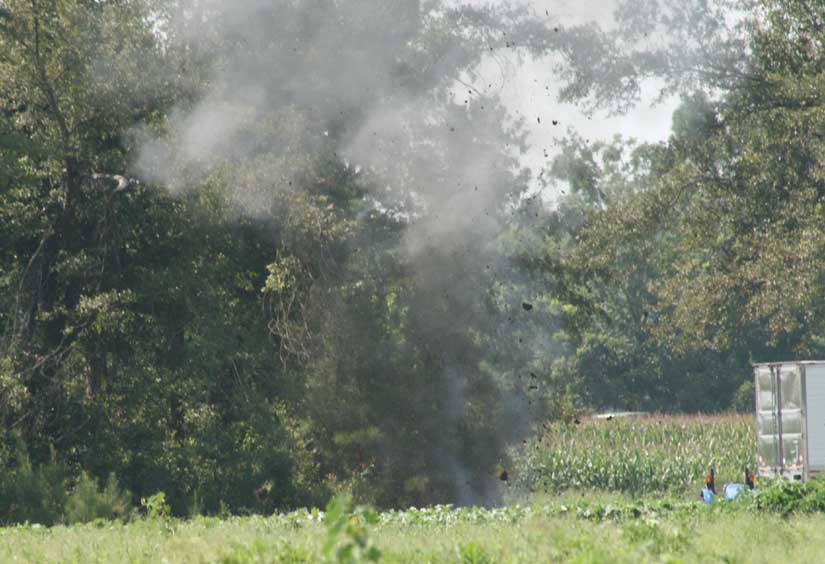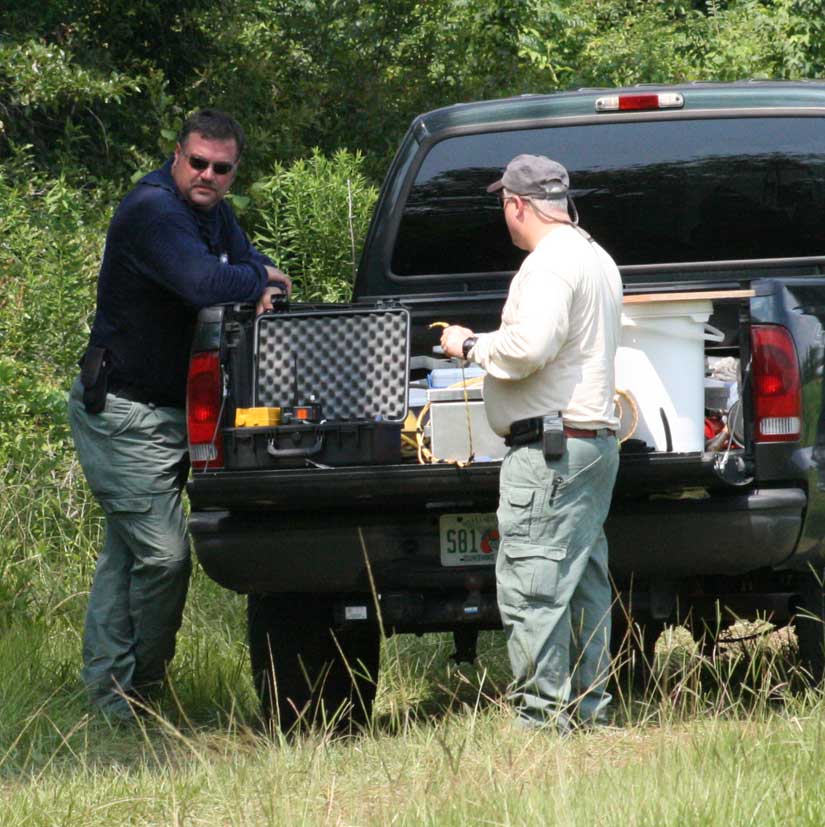Bomb Squad Blows Up Highly Explosive Acid Found In Walnut Hill
July 17, 2008
The bomb squad blew up a potentially highly explosive bottle of acid discovered Wednesday afternoon in Walnut Hill with a bang that was heard for miles.
The quart size bottle of picric acid was found in a barn on a farm in the 7800 block of Highway 97, less than a half mile from Ernest Ward Middle School. The bomb squad was called to the scene, and the Walnut Hill Volunteer Fire Department responded about 1:45.
 Picric acid was widely used in and prior to World War I as an explosive, having more explosive power than TNT. Once the liquid begins to dry out and crystallize, it’s explosive potential increases dramatically. It can detonate easily if it is bumped or shaken.
Picric acid was widely used in and prior to World War I as an explosive, having more explosive power than TNT. Once the liquid begins to dry out and crystallize, it’s explosive potential increases dramatically. It can detonate easily if it is bumped or shaken.
The plastic container (pictured left in the bomb technician’s hands) found in Walnut Hill had formed crystals known as “salts”, according to Sgt. John Corley from the Bay County Sheriff’s Department. Corley is commander of the Florida Region I Bomb Squad called to the scene.
Farm workers in the area were evacuated. Then, Corley and Sgt. Adam Buff, also from the Bay County Sheriff’s Department, carefully removed the container and placed it in water. Water decreases the volatility of the chemical.
 The picric acid was then carefully and slowly transported away from the barn in a cart on the back of a riding lawnmower (pictured left). Units from the Walnut Hill Volunteer Fire Department slowly followed behind, keeping their distance from the lone bomb squad member on the lawnmower.
The picric acid was then carefully and slowly transported away from the barn in a cart on the back of a riding lawnmower (pictured left). Units from the Walnut Hill Volunteer Fire Department slowly followed behind, keeping their distance from the lone bomb squad member on the lawnmower.
The picric acid in the water filled container was lowered into a hole dug at the back corner of a watermelon field across from Ernest Ward Middle School, and it was covered with dirt. The fire department was then allowed into the area where they wet down the surrounding grass and trees to prevent a fire.
Fire units were dispatched to standby along Highway 97 and near Arthur Brown Road. One fire truck was moved about 500 feet away into the watermelon field, upwind from the planned explosion. Firemen were told to stay behind the truck for protection. NorthEscambia.com was with that fire crew in the watermelon field.
 Bomb squad members then loaded the hole with explosives. About 3:30, they were then detonated with a loud boom that was heard up to three miles away from the scene. Smoke boiled upward from the explosion, while a water vapor cloud moved away in the wind.
Bomb squad members then loaded the hole with explosives. About 3:30, they were then detonated with a loud boom that was heard up to three miles away from the scene. Smoke boiled upward from the explosion, while a water vapor cloud moved away in the wind.
Fire crews were kept back from the explosion site for about 15 minutes until it was determined that any potential picric acid that remained was clear. Firemen then sprayed more water around the scene to further insure that all of the chemical was dissipated.
Internet research indicates that two ounces of picric has the potential explosive power of one stick of dynamite. A quart container, like the one found in Walnut Hill, would hold 32 ounces. That, at least according to the internet research, would have given the container the explosive potential of 16 sticks of dynamite.
“Since it had salted, this was potentially a very dangerous situation,” Corley said, adding that he was not sure how the container’s explosive potential would equate to sticks of dynamite. In his years with the bomb squad, he said he had never dealt with picric. Before removing the container, Corley said his team members consulted with two chemists and a military bomb squad from an area base for advice.
He said that if the picric has been accidently detonated in the barn, it could have caused significant damage to the barn and nearby people.
Corley said he estimated the power of the planned explosion to be equivalent to about eight sticks of dynamite, with that power coming from the explosives used by the bomb squad to create the blast since the picric was neutralized in water.
Besides wartime bomb making, picric was once used diluted as an antiseptic and as a treatment for burns, malaria, herpes and smallpox. It was once also synthesized into a non-explosive insecticide called chloropicrin. Chloropicrin was also used by the Germans and British as a chemical warfare agent during World War II.
It was not known why the picric acid was on the farm. It was discovered by someone in the barn who researched the chemical. Once they discovered that it was potentially explosive, a call was placed for the bomb squad.
Internet research discovered perhaps a couple of dozen incidents around the country were bomb squads had been called to destroy picric. Most of those incidents involved just a few ounces of the acid, and none involved anywhere near the quantity that would be in a quart jar.
Click here for more exclusive photos from the bomb squad incident in Walnut Hill.
Pictured top: The bomb squad blew up a bottle of highly explosive acid in Walnut Hill Wednesday afternoon. Debris from the container and dirt can be seen flying into the air in the picture. Pictured below: Sgt. Adam Buff (left) and Sgt. John Corley from the Region I Bomb Squad prepare the detonation cord used to set off the controlled explosion. NorthEscambia.com exclusive photos.
Population of Escambia County and Century declines; Population up in surrounding areas
July 16, 2008
Population estimates release Thursday by the U.S. Census bureau show declines in Escambia County, including Century, with increases in surrounding Florida and Alabama counties.
Escambia County’s population declined by 514 people from 2006 to 2007. The 2007 population was estimated at 306,407, down from 306,621 in 2006.
Santa Rosa County’s population increased over that year, up 1.8% to 147,044. In neighboring Escambia County, Alabama, the population increased from 37,577 to 37,600. And in Baldwin County, Alabama, the population surged 3,536 people, about 2.1 percent, to 171,769.
The population of Century declined by about a third of a percent from the official census in 2000 to 2007 estimates. The estimates released Thursday show Century’s population decreased by an estimated five people from 2006 to 2007, down to 1,923 people. Over the longer term, from 2000 to 2007, the population of Century is estimated to have increased 2.5% from 1,876 in 2000 to the 1,923 people in 2007.
Jay’s population increased about one percent over the seven years, from 675 to 682 people.
Atmore’s population was up from 7,411 in 2006 to 7,727 in 2007. Flomaton’s population from 2006 to 2007 was estimated to have increased by seven people from 1,530 to 1,537.
Arrr! Pirates From The Seven Seas To The Library
July 16, 2008
Ahoy, Matey! About three dozen children of all ages enjoyed a pirate adventure Tuesday at the Century Branch Library.
From stories to a silly dress up game, everything was pirate themed as the library wrapped up its Summer Reading Series.
For more photos from the pirates at the library. click here.
BOE Makes Dozens Of Personnel Appointments And Reappointments At North Escambia Schools
July 16, 2008
At their Tuesday meeting, the Escambia County Board of Education made dozens of personnel appointments, reappointments and transfers. Many of them were teachers and staff at North Escambia schools.
The personnel actions each summer are the school board’s normal course of action as teachers are employed for the upcoming school year.
The school board took action on the following teachers and staff at schools across North Escambia:
Appointments:
- Megan Driver, teacher, Molino Park Elementary School
- Rachel Venable, teacher, Molino Park Elementary School
Reappointments:
- Stephanie Abbott, Bratt Elementary School
- Lisa Albritton, Bratt Elementary School
- Raja Atallah, Northview High School
- Genia Bashore, Bratt Elementary School
- Bethany Blackburn, Northview High School
- Somer Bridges, Ernest Ward Middle School
- Megan Carroll, Northview High School
- Joseph Chastain, Northview High School
- Patricia Forehand, Northview High School
- Francis Gindl, Ernest Ward Middle School
- Cheryl Golson, Bratt Elementary School
- Sarah Green, Ernest Ward Middle School
- Gay Hassebrock, Bratt Elementary School
- Rachel Madril, Molino Park Elementary School
- Cynthia Marlo, Bratt Elementary School
- Martha Martin, Ernest Ward Middle School
- Stephani Reynolds, Bratt ElementarySchool
- Ester Robinson, Molino Park Elementary
- Mary Spence, Ernest Ward Middle School
- Jeffrey Sutherland, Northview High School
- Mary Thorpe, Bratt Elementary School
- Katie Ward, Ernest Ward Middle School
- Jesse Wolfe, Ernest Ward Middle School
Professional Appointments:
- Gregory Bass, Northview High School
- Laleta Boyce, Northview High School
- Tami Calloway, Bratt Elementary School
- Stephanie Elowsky, Northview High School
- Detria Harris, Carver/Century K-8 School
- Betty Heaton, Northview High School
- Lawrence McDonald, Northview High School
- Ericka Register, Bratt Elementary School
- Kimberly Ryan, Bratt Elementary School
- Scott Slay, Northview High School
- Leah Stuckey, Carver/Century K-8 School
- William Wheatley, Northview High School
Transfers:
- Heather Gilman from Ransom to Bratt Elementary
- William Gott from Carver/Century to Workman
- Arthur Johnson from Ernest Ward Middle to George Stone
Out-of-field Reappointments:
- Jennifer Castor, Northview High School
- Billy Welch, Northview High School
Resignations, Retirements, Other:
- Elaine Barrow, Molino Park Elementary
- Stephanie Bloomer, Bratt Elementary
EEE Case Reported Near North Escambia
July 16, 2008
A case of Eastern Equine Encephalitis (EEE, pronounced “Triple E”) in a child in nearby Seminole, Alabama, is prompting Escambia County (Florida) Health Department officials to urge residents and visitors to take some recommended precautions.
Seminole is just 13 straight line miles from Molino.
EEE is a serious disease and can be fatal to infants, children and the elderly. Because of the high death rate, EEE is regarded as one of the most serious mosquito-borne diseases in the United States. About one-third of those that contract EEE died.
The disease is highly fatal in horses, with about 90 percent of all horses that contract the disease dying.
Florida Agriculture and Consumer Services Commissioner Charles Bronson is urging horse owners to get their animals vaccinated as the number of EEE cases are on the rise.
As of June 30, there are four times as many cases as there were during the same time period in the two previous years. There have been 45 confirmed cases covering 21 counties as far south as Palm Beach County. In the first six months of 2007, there were 11 cases and the same number in 2006.
“We have had two relatively quiet years in a row and I am concerned that horse owners may get complacent and delay having their animals properly vaccinated,” Bronson said. “But with the rainy season starting to resume, we are likely to see a lot more mosquitoes than we have during the two years of drought.”
Bronson says the majority of cases of EEE and West Nile Virus in horses can be prevented through proper vaccinations against mosquito borne illnesses. Bronson said that now is the time for horse owners to take action. Horse owners are urged to check with their veterinarian to make sure their animals have received current vaccinations and booster shots against WNV and EEE, and that these shots are kept up to date.
The health department says residents and visitors should take these precautions to protect themselves:
- Dusk and Dawn: Do not go outdoors when mosquitoes are seeking blood during the twilight hours of dusk and at dawn.
- Dress: Wear clothing that covers most of your skin.
- DEET: When the potential exists for exposure to mosquitoes, repellents containing DEET are recommended. Check labels before using a product on infants and children. If an infant is too young to wear repellent and must be outdoors, a parent should place mosquito netting over the infant’s carrier. Picaridin and oil of lemon eucalyptus are other repellent options for individuals who cannot wear DEET.
- Drainage: Check around your home to rid the area of standing water, which is where mosquitoes can lay their eggs. Elimination of breeding sites is one of the keys to
prevention. - Screens: Make sure window and door screens are in good condition, without any tears or holes that allow mosquitos to enter your home. Place screens on open windows.
- Clean out eaves, troughs and gutters.
- Remove old tires or drill holes in those used in playgrounds to drain
- Turn over or remove empty plastic pots
- Pick up all beverage containers and cups.
- Check tarps on boats or other equipment that may collect water.
- Pump out bilges on boats.
- Replace water in birdbaths and pet or other animal feeding dishes at least once a week.
- Change water in plant trays, including hanging plants, at least once a week.
- Remove vegetation or obstructions in drainage ditches that prevent the flow of water.
Free Caregiver Training Friday
July 16, 2008
The Council on Aging of West Florida is offering a free caregiver training session on Friday, July 18 from 12:30 p.m. until 3:30 p.m. at the Century Senior Center/Council on Aging of West Florida Congregate Meal Site located at 6025 Industrial Blvd. in Century.
The topic will be Taking Care of Both Caregiver and Care Receiver. The training session is for all caregivers, regardless of the condition the receiver has. The training session, which includes lunch, is free. Reservations are requested to 432-1475.
The training will focus on issues caregivers face and an extensive caregiver’s manual, which has been designed as a reference guide, will be distributed free of charge to attendees. The manual includes programs and resources available to assist caregivers, tips for caregiving, safety issues, emergency preparedness and how to safely provide physical care, personal care and nutrition as well as how to deal with behavioral problems and grief issues.
The training is part of new programs designed to reduce stress, increase coping skills, provide strategies for effective management of caregiving tasks and enable caregivers to provide high quality care in the home. The programs are sponsored by Council on Aging of West Florida, the State of Florida Department of Elder Affairs, and the Northwest Florida Area Agency on Aging.
Council on Aging of West Florida is a local, independent 501(c)(3) not-for-profit organization that has served seniors and their families since 1972. Council on Aging of West Florida helps seniors in Escambia and Santa Rosa Counties live healthy, safe and independent lives in their own familiar surroundings by providing community based, in-home programs and services such as Meals on Wheels and Alzheimer’s respite care.
Red Flag Warning Today
July 15, 2008
The National Weather Service has issued a Red Flag Warning for today for the North Escambia area.
The warning is in effect from noon today until 7:00 tonight.
Afternoon relative humidities were forecast to drop below 35 percent after noon and then return above 35 percent by 7:00 tonight.
A red flag warning means that dangerous fire weather conditions are either occurring now… or likely will occur. A combination of low relative humidity and warm temperatures will create explosive fire growth potential. Outdoor burning should be restricted.
“B” Grade Might Not Save Carver/Century; Paul Still To Recommend Closure
July 15, 2008
Improving from an “F” school to a “B” school is not likely to save Carver/Century K-8 School.
Escambia School Superintendent Jim Paul is still expected to recommend the closure of the school for the 2009-2010 school year, but that recommendation is now expected to come at the school board’s August 19 meeting rather than today’s meeting.
“His tentative plan is to bring the recommendation to the August 19 board meeting,” Associate Superintendent Ronnie Arnold told NorthEscambia.com.
“He was very happy for the Carver/Century community for the ‘B’ the school received,” Arnold said of Carver/Century’s school grade announced this week by the Florida Department of Education. “The grade itself does not have a bearing on any potential closure recommendation.”
Arnold pointed out that Paul recommended the closure of Pensacola Beach Elementary School in 2001 despite of the school’s grade. In the 1999-2000 school year, Pensacola Beach Elementary was ranked as an “A” school with 100 percent of students scoring at grade level or above on both the reading and math FCAT. In Pensacola Beach Elementary’s last year, 2000-2001, the school had slipped from an “A” to a “B” rating.
“He recommended the closure of Pensacola Beach Elementary in 2001 for many of the same reasons he would recommend the closure of Carver,” Arnold said of Paul’s recommendation. “Simply stated, the cost-per-student to operate schools of such small population.”
Numbers NorthEscambia.com obtained in May from the Escambia County School District indicate that of the 314 elementary age children in the Carver/Century attendance zone, only 126 actually attended the school. Almost 40 percent of them, 121 in all, attended Byrneville Elementary School, a public charter school.
Another 48 attended Bratt Elementary School, and 11 attended Molino Park. There were three at Jim Allen Elementary School, three at Ensley Elementary School, one at N.B. Cook Elementary and one at Warrington Elementary School.
On the middle school side of Carver/Century, about 56 percent of the students that live in the Carver/Century district attended the school last year. The school district reports that of the 159 middle school students in the zone, 89 did attend Carver/Century. Another 68 went to Ernest Ward Middle School and two attended Ransom Middle School.
These numbers do not account for students that may live in theCarver/Century school zone that were home schooled, attended a private or church school, may have attended school across the state line in Alabama, or that may have attended school in Santa Rosa County.
Trial Delayed For Molino Man Accused In Young Daughter’s Death
July 15, 2008
Trial has been postponed for a Molino man accused of killing his infant daughter.
Christopher Paterson, 28, was scheduled to stand trial Monday for the death of his one year old daughter Ali Jean Paterson.
But Assistant Public Defender Fred Carmody requested that the trial be postponed so an expert witness could prepare for the trial. The continuance request was granted by Circuit Judge Michael Allen.
The trial is now set to begin with jury selection on July 28 according to court officials. The trial had previously been set to begin on May 12, but was postponed after the defense announced a new witness in the case.
The girl died on November 26, 2006, from burns she received two weeks earlier when she was left unattended in a hot bath, according to authorities. Paterson told deputies he placed the child in shower that just felt warm and went to another room to get a towel. He said that when he returned, Ali was screaming, and there was steam rising from the shower. He then called 911 after noticing red sores on the child.
Ali survived at Children’s Hospital in Birmingham for two weeks before she died.
This was not Paterson’s first involvement with authorities over Ali. The Department of Children and Families investigated a broken leg she suffered in May 2006. Paterson and Brittany Knapp, Ali’s mother, took Ali to the hospital with a broken leg. They said her leg was broken when it became trapped in a slot in her crib. DCF did not find that the incident was abuse at that time.
Paterson was indicted by a grand jury on second degree manslaughter charges in February of 2007. He was arrested on May 1, 2007, near Gainesville. He has remained in jail since his arrest.
A Bumper Crop Of Figs
July 15, 2008
Many area backyard fig growers are reporting a bumper crop this year across North Escambia.
In the Walnut Hill fig tree pictured above, there was an extra surprise…a bird’s nest about five feet off the ground with three blue speckled eggs inside.
The National Fig Council says:
“Figs, a recognized powerhouse of nutrition, have provided sustenance for as long as there has been dietary history. As early as 2900 BC, in early Sumerian times, the medicinal use of figs was stressed. Known for their fiber content, figs also contain more calcium, more potassium, and more iron than other common fruits. Fresh figs also contain important antioxidants.
“Fresh figs have long been the darling among discerning chefs, who have used the elegant specialty in a broad spectrum of culinary treasures including appetizers, sauces, salads, entrees and dessert.”
But around North Escambia, perhaps nothing beats a hot buttered biscuit with fresh fig preserves.
NorthEscambia.com photos, click to enlarge.








